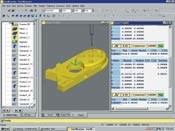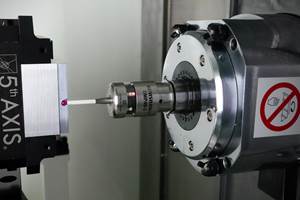Opening Up Metrology
The current state of metrology equipment mimics the disparity of spoken languages. Proprietary operating systems, available on metrology equipment from CMMs to hand-held electronic gages, are unique to the manufacturer. Getting data from one measurement operating system into another requires translation and interpretation of the data. In many cases, just like language, some design intent and nuances of the data can get lost in translation.
EDITOR'S NOTE: In mid-2002, Xygent was purchased and absorbed by Brown & Sharpe. Any inquiries regarding metrology software applications found in this article should be directed to Brown & Sharpe.
In much the same way that Bill Gates’ Microsoft Windows has been accepted as a standard operating platform for most PCs, Xygent, Inc. (Warwick, Rhode Island) hopes to use its suite of enterprise-wide metrology architecture and application products to integrate data from object measurement into the manufacturing process. In general, the idea is to use Xygent’s software as an independent operating system that creates compatibility among different metrology devices.
Think of it this way. How much better would international relations be if everyone spoke a common language? Well in truth, maybe international relations wouldn’t change dramatically, but the point is the communication process would be much more streamlined without the need for translators, interpreters and interpretation.
The current state of metrology equipment mimics the disparity of spoken languages. Proprietary operating systems, available on metrology equipment from CMMs to hand-held electronic gages, are unique to the manufacturer. Getting data from one measurement operating system into another requires translation and interpretation of the data. In many cases, just like language, some design intent and nuances of the data can get lost in translation.
For manufacturers, this sets up an inefficient need to go back and forth between the native data and the interpreted data to get it right. The whole process is about making good parts. What Xygent hopes to do is implement its XactCOM operating system as a universal language that supercedes the current myriad of proprietary systems available to shops, enabling them to work from common and comprehensible data. One could think of it as the metrology equivalent of Esperanto (the global language proposed some decades back).
Xygent’s system is not a translator but an operating system that runs on top of Windows. With a suite of open software programs, called XactMeasure, XactVision, Xact CNC and XactGage, it can actually supplant proprietary metrology software and allow for seamless communication among different pieces of metrology equipment anywhere in the shop, or the world, that uses this operating system.
The measurement function in much of manufacturing has become relegated to a role of post process data gathering intended to pass/fail the manufacturing process. For many manufacturers, this is an additional step in the process that has little or no value added benefit. It’s a necessary evil.
This view is generally held, in part, because the metrology data is currently a dead end as far as its usefulness beyond inspection. With the XactCOM operating system, this data could be used for more than just inspection.
For example, many shops manufacture discrete parts. The discrete parts eventually become an assembled component. The OEM who contracts for the production of these discrete parts may source the work to a variety of shops. While each shop works off a common CAD file, the measurement data gathered from inspection of the first article is proprietary to the shop’s measurement equipment and simply confirms that the part is in spec (pass/fail). Each of the contract shops then confidently sent its parts to the OEM for try-out and assembly. If the parts need to be tweaked to fit, the OEM must go back to the shop with an adjusted CAD file to reflect the tweak. Another part is made, measured and the process is repeated.
Now envision the OEM’s suppliers using a common metrology operating system such as Xygent is proposing. Instead of shipping the discrete workpiece from each supplier shop, the measurement data can be sent and the assembly simulated with a virtual model of the actual part. Comparison between the CAD designed part and the manufactured part would allow for adjustments to be made via the Internet. The try-out and assembly could be done by wire instead of shipping physical parts to a physical location.
Xygent was founded in 1997 and was formerly known as Brown and Sharpe Information Systems. This group is now an independent business unit and brings with it 15 years of development in algorithms, technologies and embedded functions that were created under the Brown and Sharpe Information Systems Inc. umbrella. This company knows measurement.
Related Content
How To Calibrate Your Calipers
If you’re interested in calibrating your own digital, dial or Vernier calipers, here are some steps to take to make sure it goes off without a hitch.
Read MoreChoosing the Correct Gage Type for Groove Inspection
Grooves play a critical functional role for seal rings and retainer rings, so good gaging practices are a must.
Read MoreA Case for Combining Workholding with Optical Scanning
Automotive dies and die inserts are often complex, one-off parts with little room for error. Integrity Tool's investments in modular workholding tools and 3D optical scanning have allowed the company to create niche capabilities for its CNC machined parts.
Read MoreWhat Should Machinists Know About In-Machine Probing?
In-machine probing doesn’t reach the power of CMMs but can still be useful for pre- and mid-process control, as well as for “rough screening” of parts.
Read MoreRead Next
The Cut Scene: The Finer Details of Large-Format Machining
Small details and features can have an outsized impact on large parts, such as Barbco’s collapsible utility drill head.
Read More3 Mistakes That Cause CNC Programs to Fail
Despite enhancements to manufacturing technology, there are still issues today that can cause programs to fail. These failures can cause lost time, scrapped parts, damaged machines and even injured operators.
Read More





























